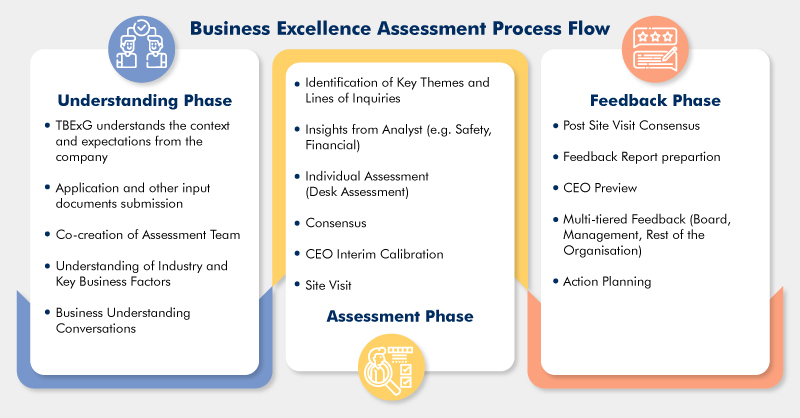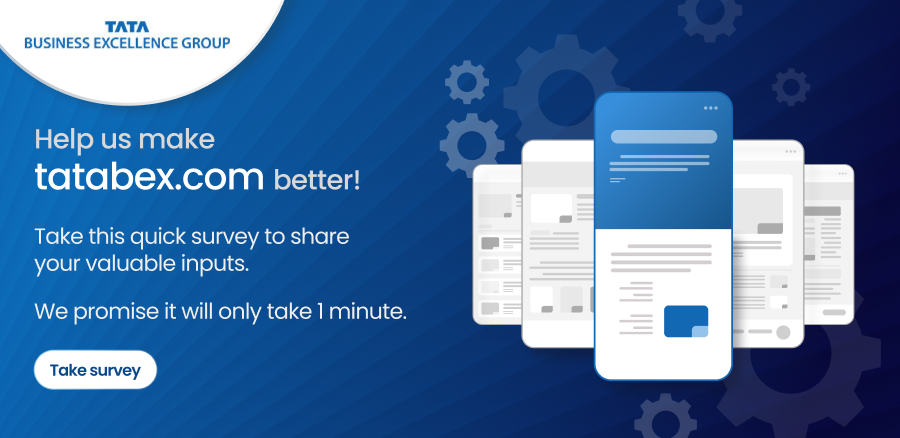
The foundation of Business Excellence movement in the Tata Group was enabled by adopting the JRD Quality Value for Performance Excellence and promoting a unified common Tata brand name. Tata Business Excellence Group (TBExG) is entrusted to build and nurture an institutionalised approach to drive the business excellence movement at the Tata group. It sets standards of excellence and partners with group companies in their journey to achieve world-class performance.
This journey has been institutionalised through a virtuous cycle of performance excellence which has evolved over the years. This starts with Assessing the progress of the companies using excellence frameworks, accelerating progress through Improvement Interventions, and nurturing an ecosystem of learning and sharing from each other.

Customer Testimonials :

The Assessment Process
The Business Excellence Assessments, using the Tata Business Excellence Model (TBEM ) framework has been an integral part of organisational management practices in the Tata group. They have been quietly assisting the leadership in strengthening the strategic and operational capabilities of Tata companies since its inception. The inclusive nature of the model, with its multi-stakeholder focus, has been inspiring companies to move up in their journey of excellence.
TBEM is based on the Malcolm Baldrige National Quality Award Model of the U.S. The TBEM Criteria is continually revised in response to the changing business environment and assists companies in keeping pace with the developments and increasing competitiveness. Tata Sons is now the Founding Member of the Mac Baldridge Society® and Lifetime Trustee of the Baldridge Foundation’s Institute for Performance Excellence.
The approach to Business Excellence Assessments is aligned to the principles of 3Cs - Customised, Collaborative and Celebrated thereby delivering more Purpose Led Assessments with n=1 approach for each company. Broadly there are two types of Business Excellence Assessments designed to suit the differential needs of the companies:
- Enterprise-wide Assessment
- Enterprise + Business Unit Assessment
Companies choose to participate in either format of the assessment based on size and geographical spread of the organisation, organisation structure and complexity.
The Business Excellence Assessment Process can be imagined into three phases:

1. Understanding Phase:
This phase aims to bring all the key stakeholders together to design and deliver the assessment well. The critical aspects of the assessment is discussed and an Approach Note of an assessment is collectively curated. The inputs from the Assessee company gets translated into the design of the assessment. Curating a winning assessment team with right set of experience and knowledge is a critical step in this phase. The team then spends enough time to understand the company by studying the application and other input documents and leveraging the other touchpoints like Industry Briefing, Key Business Factor meeting and Business understanding conversations.
2. Assessment Phase:
Once the Assessment team understands the Assessee company, it then gets into the identification of Key Themes of the assessment which are mostly aligned to the strategic aspirations of the Assessee company. The related lines of inquiries are also determined at this stage. During the final feedback presentation, the assessment team weaves the entire feedback around these key themes. Assessment Teams begin the individual/desk assessments.
Each Team also gets additional insights from Analysts in the areas like Safety and Finance to augment their business and contextual understanding. The individual wisdom is translated into collective wisdom through the process of consensus. Since the entire assessment process is designed to be collaborative, the initial findings are also calibrated with the CEO of the Assessee company before the team plans and engages in the Site Visit where the critical site visit issues or questions are clarified.
3. Feedback Phase:
The philosophy of n=1 approach, customisation, and collaboration with the stakeholders has made the Business Excellence Assessments more purpose-led ( Focus on Future), thereby nurturing the ecosystem to deliver. The feedback phase aims to synthesise the insights into a multi-tiered feedback mechanism. Formal feedback on what the Assessee company should continue and what it should enhance or explore is woven in the lines of Key Themes. While a detailed feedback is presented to the Management, a summarised version is also shared with the Board of the company subsequently.
Based on the feedback received post the assessment, companies create and update their business excellence action plans and continues to improve in their quest to emerge as a world class organisation..
Every year many Tata companies participate in business excellence Assessments, and the spirit of Excellence is celebrated. The unstinted efforts put in by the companies, Mentor, Team Leader and Assessors are acknowledged in in the Business Excellence Convention (BEC) while the achievements of certain milestones by the companies are recognised at the JRDQV function on July 29.









